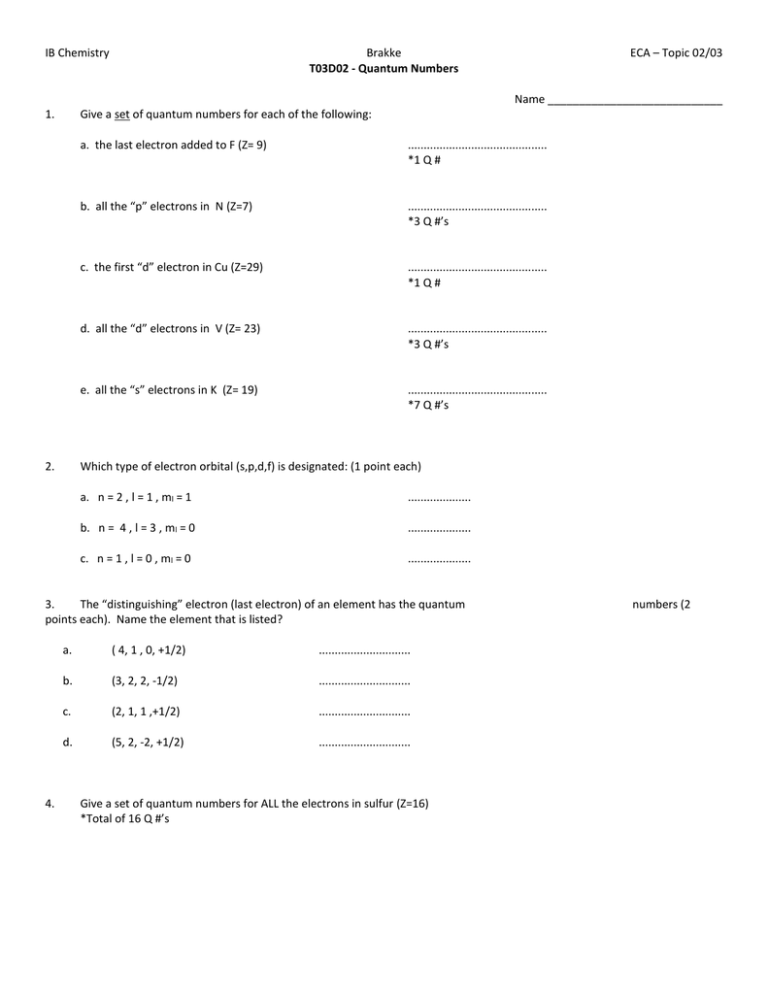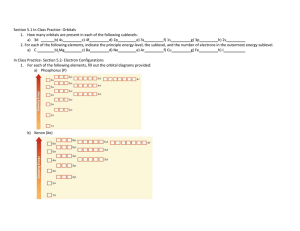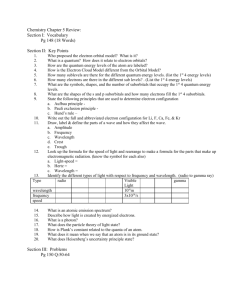IB ChemistryBrakkeECA – Topic 02/03 T03D02
advertisement

IB Chemistry Brakke T03D02 - Quantum Numbers ECA – Topic 02/03 Name ____________________________ 1. Give a set of quantum numbers for each of the following: 2. a. the last electron added to F (Z= 9) ............................................ *1 Q # b. all the “p” electrons in N (Z=7) ............................................ *3 Q #’s c. the first “d” electron in Cu (Z=29) ............................................ *1 Q # d. all the “d” electrons in V (Z= 23) ............................................ *3 Q #’s e. all the “s” electrons in K (Z= 19) ............................................ *7 Q #’s Which type of electron orbital (s,p,d,f) is designated: (1 point each) a. n = 2 , l = 1 , ml = 1 .................... b. n = 4 , l = 3 , ml = 0 .................... c. n = 1 , l = 0 , ml = 0 .................... 3. The “distinguishing” electron (last electron) of an element has the quantum points each). Name the element that is listed? 4. a. ( 4, 1 , 0, +1/2) ............................. b. (3, 2, 2, -1/2) ............................. c. (2, 1, 1 ,+1/2) ............................. d. (5, 2, -2, +1/2) ............................. Give a set of quantum numbers for ALL the electrons in sulfur (Z=16) *Total of 16 Q #’s numbers (2 IB Chemistry Brakke ECA – Topic 02/03 5. Give a set of quantum numbers to describe the LAST electron (sometimes called the distinguishing electron) in each of the following – assume all are neutral species: 6. 7. 8. 9. a. neon ……………………. b. phosphorus ……………………. c. tungsten ……………………. d. xenon ……………………. What is the maximum number of electrons that can be identified with each of the following sets of quantum numbers? [none or 0 is a possible answer] a. n = 2 and l = 1 …………… b. n=5 …………… c. n = 4 and l = 4 ……………. d. n = 3, l = 1 and ml = -1 ,,,,,,,,,,,,,,, e. n = 4 and l = 2 ………… f. n = 3, l = 0, and ml = +1 ………….. What is the: a. Minimum n value when l = 3? …………….. b. Letter (s,p,d or f) used to designate sublevel with l = 2 ……………. c. Number of orbitals in a sublevel with l = 4 …………….. d. Number of different sublevels with n = 4 Assign a set of 4 quantum numbers to describe a. each of the 5s electron(s) in antimony (Sb) b. all the d electron(s) in rhodium (Rh) c. all the p electron(s) in chlorine (Cl) For how many electrons in silver (Ag) does a. n=5, l = 1 , ml = 0, ms = +1/2 ………………… b. n = 4, l = 1 ………………… c. n = 3, l=2, ml = 1 ………………… ……………..








